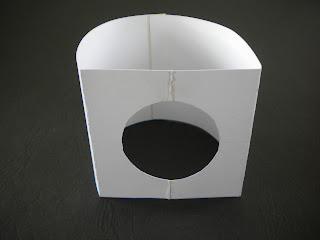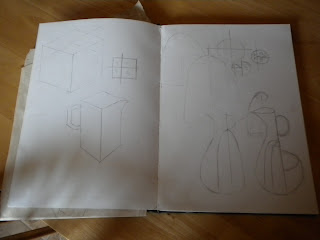3rd Year start-up Brief
This project relates to our 'throw away' society.
Contemporary society is a throw away society. There is packaging that is designed to enhance and sell a product, but there is also packaging that is produced for a very specific object. This packaging has in itself a very particular aesthetic derived from its function rather than styling. Its aesthetic also comes from the design, the quality of engineering and materials and production process. This latter type is the kind I am asked to focus on.
I began to research this kind of packaging. I started looking at bags, boxes, wrapping paper, ribbons etc. I drew out certain pieces of packaging that interested me.
I became particulary drawn to the packaging templates, such as the templates of cereal boxes, sweet boxes, soap boxes and mobile phone boxes.
The mobile phone box above is one I began to draw and look at all the different sections.
I included the lines, circles and half circles in my research. From this I began to make my own templates and make paper models of my own.
Below are some of the paper models I created using my own templates.

I cast the plaster model with the outer shape of a cube. Without any difficulty the model separated from the mould.
I then decided to make a second cast of the plaster model with a round outer shape.


Below I cut the round mould in half and gave the outside a triangular shape.
I love the shape below in which I got from re-shaping the orginal mould.
As shown below, I also cut up the cube mould into quarters and ended up with an interesting shape. I now used the cut up shapes as models.
I now made a mould of the plasters models in which I had cut up, I did this in order to make several casts of the model. When I cast and completed a number of these forms, I put them together and played around with different arrangements. The cast pieces were made from stoneware slip.

For surface decoration I looked back at my sketckbook and the sweet boxes I started out with. The sweet boxes had loads pretty decorations on them in which I wanted to incorporate in my design.
I loved the form of these pieces but I was starting to get stuck. As a product designer I would rather make the pieces functional rather than ornamental. I looked at the arrangement of the pieces and tried to think of a function they could serve.
Looking at this set of four I thought the size and arrangement was suitable for a table centre.
As I work in a restaurant myself, I thought they reminded me of a set of salt, pepper, milk and sugar.
So experimenting with this idea I thought of ways I could transform these objects into the functional set of salt, pepper, milk and sugar.
I thought maybe if I changed this set up the form could work themselves and salt, pepper, etc..
I experimented with making a jug for milk.
Above is a jug I made out of the original form but it was difficult to clean up and it basically just didn't work out. I now became stuck, when I realised the form wouldn't work as the functional set I wanted.
With much thought I looked back and planned out what I wanted.
I wanted a functional table centre suitable for a restaurant. I wanted a set of milk, sugar, salt & pepper.
From my sketchbook, I kept the idea of designing a set of similar objects fitting together to make up a separate form.
I had to design these objects in a way they would work best for their specific function i.e. salt, pepper.
I began drawing in my sketckbook again until I was happy with my design.
First I started to experiment with shape, and what shape would best suit the functional set.
Above; Playing around with different ways of the set fitting together.
My original idea was to have a set of four objects all of the same size cut into quarters. But realistically the dimension of a milk jug and a salt shaker would not be same size, clearly the salt and pepper shaker would be smaller. So I changed the original set of four, to a set of five. As the set was for a restaurant I decided it the extra piece would be useful to hold sachets of butter/ketchup/vinegar etc..
The heights of each piece would be different, the milk jug would be taller than the other pieces. Following the anti-clock-wise direction, each piece took one small step down in height from the other.
Above is the way I designed the set to fit together.
I chose the above shape in my design, and now I was designing the functional set around that shape.
I turned the shape I wanted on the wheel, and I cut it up into the five different pieces I wanted to complete my design.
Below are images from my sketchbook where I designed each piece from the set.
After designing the five piece restaurant set, I thought it would be nice to have a plate or small dish to hold them together, it would also be more convenient for waiters to clear the set from restaurant tables.
Below I began designing a small plate in order to hold the set together.
Below are photos of the ceramics I designed.
With shortage of stoneware clay I made the pieces with earthenware slip.
I made a slight angle at the front of the salt and pepper shakers, where I also inserted the tiny holes for salt and pepper to easily fall out.I inserted small indentations on the salt, pepper and milk jug. I added these to the design in order for someone to pick up the pieces easily. Also when the pieces are joined together the indentations form a shape of their own.
The indentations on the milk jug are at two different heights. This is because it was the most natural way your hand would fall in order to pick up the jug.
The set above to hold sugar and sauce sachets were pretty straight forward. They did not need any indentation, as they wouldn't have to be picked up from the plate. They just had to be suitable to hold sachets of sugar/sauces.
In order to make the plate, I got the correct measurements from the bottom of the five piece set joined together. On the plate, I lowered the centre were the set would sit into perfectly.
I made the front of the plate on the lathe. I left a space around the bottom of the place which left it easy for someone to pick up the plate. I turned the bottom of the plate on the wheel.
Below is an image of the bottom of the plate.
Above; Top profile picture of the set.
Above; Side profile picture of the set.
I want to glaze the table set with a plain glaze such as white, black or clear.
























































.
ReplyDelete